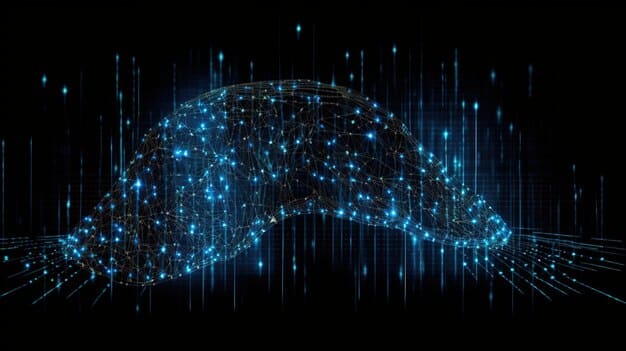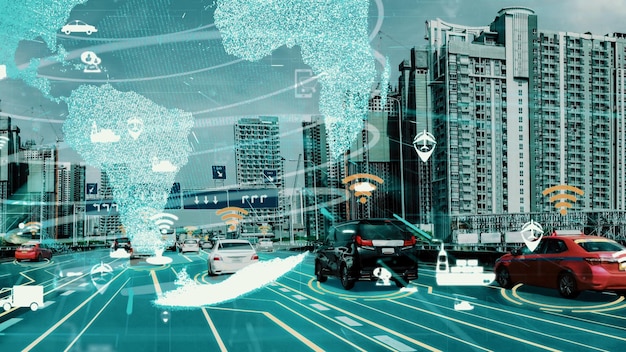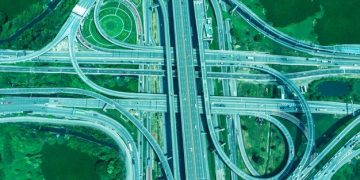Legal & Ethical Autonomous Vehicle Considerations in US

The advent of autonomous vehicles on US roads introduces complex legal and ethical dilemmas concerning liability, safety, data privacy, and societal impact, necessitating a robust regulatory framework to ensure responsible deployment and public trust.
The dawn of self-driving cars promises a revolution in transportation, but as these sophisticated machines begin to share our roadways, crucial questions emerge. What are the legal and ethical considerations of autonomous vehicles on US roads? This isn’t just about technology; it’s about navigating a complex landscape of accountability, human values, and societal transformation that demands careful consideration and intelligent regulation.
Navigating the Regulatory Landscape for Autonomous Vehicles
The emergence of autonomous vehicles (AVs) has placed federal and state governments in a challenging position: how to regulate a rapidly evolving technology without stifling innovation. This section explores the current state of regulatory efforts, illustrating the patchwork of laws and guidelines that define the legal environment for AVs in the United States.
At the federal level, the National Highway Traffic Safety Administration (NHTSA) plays a pivotal role, primarily through its voluntary guidance documents rather than prescriptive regulations. These guidelines aim to encourage safety by outlining best practices for AV developers, covering aspects like vehicle design, testing, and data recording. However, the lack of binding federal standards creates a varied legal terrain across states.
Federal Guidance and State Initiatives
While federal agencies like NHTSA provide non-binding frameworks, individual states have taken the lead in legislating AV deployment. This decentralized approach has led to a mix of progressive and cautious stances, impacting where and how AV technologies can be tested and operated.
- NHTSA’s Voluntary Guidelines: These documents, such as “Automated Driving Systems 2.0: A Vision for Safety,” outline a multi-layered approach to safety, emphasizing rigorous testing and transparent reporting. They serve as a foundational, though not legally enforceable, guide for manufacturers.
- State-Level Autonomy: States like California, Arizona, and Michigan have enacted specific laws permitting AV testing and deployment, often requiring permits, reporting, and certain safety drivers. Other states remain hesitant, prioritizing caution over rapid adoption.
- Uniformity Challenges: The varying state laws create complexities for manufacturers aiming for nationwide deployment, often requiring them to adapt their technologies and operational procedures to different regulatory environments. This fragmentation can hinder the efficient scaling of AV technologies across the US.
The regulatory evolution is ongoing, with significant challenges remaining in creating a cohesive national framework. Stakeholders, including policymakers, industry leaders, and consumer safety advocates, continue to debate the most effective path forward – one that balances innovation with public safety and accountability.
In summary, the regulatory landscape for autonomous vehicles in the US is characterized by a dynamic interplay between federal guidance and diverse state-specific legislation. This evolving environment necessitates continuous monitoring and adaptation by manufacturers and a concerted effort towards greater uniformity for widespread and safe AV integration.
Establishing Liability in Autonomous Vehicle Accidents
One of the most complex and contentious legal challenges presented by autonomous vehicles is determining liability in the event of an accident. Unlike traditional collisions where human error is typically a primary factor, AV accidents introduce new questions about who is responsible: the vehicle owner, the manufacturer, the software developer, or even the sensor supplier? This section delves into the shifting paradigms of liability in an AV world, exploring current legal thinking and potential future frameworks.
Traditional tort law, which governs civil wrongs and damages, is predicated on concepts of negligence and product liability. When a human driver is at fault, negligence is typically straightforward to prove. However, with AVs, the concept of “fault” becomes blurred. Is it a defect in the vehicle’s hardware, a flaw in the AI’s decision-making algorithm, or misuse by the human occupant? These questions necessitate a re-evaluation of existing legal precedents.
Product Liability vs. Negligence
The current legal debate often boils down to whether autonomous vehicle accidents should be treated under product liability law or traditional negligence principles. Each approach has its implications for manufacturers, consumers, and insurance companies.
- Product Liability: This approach focuses on whether the vehicle itself was defective in design, manufacturing, or warnings. If an AV’s autonomous system is deemed to be the cause of an accident due to a flaw, the manufacturer could be held strictly liable, regardless of their direct negligence.
- Traditional Negligence: This concept would apply if a human driver was still in control or able to intervene, but failed to do so. However, as AVs become more capable and require less human oversight (Level 4 and 5 autonomy), the scope for human negligence diminishes significantly.
- Shared Responsibility Models: Some propose hybrid models where liability could be shared among multiple parties, considering the level of automation, the circumstances of the accident, and the actions of any human override. This would require novel legal frameworks and mechanisms for fault apportionment.
The role of insurance also comes into sharp focus. As liability shifts from the driver to the vehicle itself or its manufacturer, traditional auto insurance models may need significant adjustments. New types of product liability insurance for manufacturers or comprehensive “no-fault” schemes for AVs might become necessary to ensure victims are compensated efficiently.
Ultimately, establishing clear and equitable liability rules for autonomous vehicles is crucial for building public trust and ensuring a fair system of compensation. Without unambiguous guidelines, the uncertainty could hinder AV adoption and leave accident victims in a legal quagmire, highlighting the urgent need for legislative clarity.
Ensuring Data Privacy and Cybersecurity in Autonomous Systems
Autonomous vehicles are essentially data-collecting machines on wheels, gathering vast amounts of information about their surroundings, occupants, and operational performance. This data, which often includes location, biometric, and behavioral patterns, raises significant privacy concerns. Simultaneously, the interconnected nature of AVs makes them potential targets for cyberattacks, posing risks to safety, data integrity, and national security. This section explores the dual challenges of data privacy and cybersecurity within the autonomous vehicle ecosystem.
The sheer volume and sensitivity of data collected by AVs demand robust privacy frameworks. Information about travel habits, frequented locations, and even in-cabin conversations could be vulnerable to misuse, tracking, or unauthorized access. Establishing clear guidelines on data collection, storage, usage, and sharing is paramount to protecting individual rights.

Privacy Protocols and Cyber Resilience
Addressing data privacy requires comprehensive policies that grant individuals control over their information, while cybersecurity demands resilient systems capable of defending against evolving threats. Both are intertwined in the safe and ethical deployment of AVs.
- Data Minimization and Anonymization: Companies should adopt practices that collect only necessary data and anonymize it where possible to reduce privacy risks. Clear consent mechanisms for data collection are also essential.
- Robust Encryption and Access Controls: Protecting data both in transit and at rest through advanced encryption and strict access controls is fundamental. This prevents unauthorized interception or access to sensitive information.
- Over-the-Air (OTA) Updates: While beneficial for system improvements and bug fixes, OTA updates also present a cybersecurity vulnerability. Secure update mechanisms are critical to prevent malicious code injection.
- Threat Detection and Response: AVs and their supporting infrastructure must have continuous monitoring capabilities to detect and respond to cyber threats in real-time, preventing potential vehicle takeovers or data breaches.
Furthermore, transparency regarding data practices is key to building consumer trust. Manufacturers and service providers must clearly communicate what data is collected, why it’s needed, and how it’s protected. Establishing independent audits and regulatory oversight can also help ensure compliance with privacy and security standards.
In essence, the future of autonomous vehicles hinges not just on their ability to drive safely, but also on their capacity to safeguard personal data and resist cyber threats. Neglecting these areas could lead to a significant erosion of public confidence, undermining the transformative potential of AV technology.
The Ethical Implications of Algorithmic Decision-Making
Perhaps the most profound and philosophically challenging aspect of autonomous vehicles lies in their algorithmic decision-making, particularly in unavoidable accident scenarios. When an AV faces a situation where harm is inevitable, how should it be programmed to choose? Should it prioritize the lives of its occupants, pedestrians, or minimize overall harm? These are deeply ethical dilemmas with no easy answers, forcing society to confront difficult moral questions previously reserved for human judgment.
The “Trolley Problem,” a classic philosophical thought experiment, vividly illustrates these challenges in the context of AVs. While these scenarios are thankfully rare in real-world driving, the need for an AV to make a “choice” in a fraction of a second, with potentially fatal outcomes, demands an ethical framework embedded directly into its programming. This framework reflects societal values, which can vary significantly across cultures and demographics.
Programming Morality into Machines
The task of instilling moral judgment into algorithms requires careful consideration of various ethical theories and their practical application. This involves more than just optimizing for safety and efficiency.
- Utilitarianism: This principle suggests programming AVs to choose the action that results in the “greatest good for the greatest number,” potentially sacrificing the occupants to save more lives outside the vehicle. This approach raises questions about individual rights and consumer acceptance.
- Deontology: This framework emphasizes moral duties and rules, regardless of consequences. An AV programmed under deontological principles might prioritize obeying traffic laws absolutely, even if it leads to a worse outcome in specific situations.
- Risk Minimization: A more pragmatic approach might focus on minimizing collisions regardless of who is involved, or consistently prioritizing the safety of vulnerable road users (pedestrians, cyclists).
- Transparency and Explainability: It’s crucial for the public to understand how AVs make decisions, especially in critical situations. “Black box” algorithms that lack explainability erode trust and make accountability difficult.
Beyond accident scenarios, ethical considerations extend to the broader societal impact of AVs. This includes issues like job displacement in the transportation sector, accessibility for people with disabilities, and the potential for autonomous monitoring and control by authorities. These broader ethical implications require ongoing public discourse and policy development.
In essence, developing ethical guidelines for autonomous vehicles goes beyond programming code; it involves grappling with fundamental human values and constructing societal consensus on how machines should operate in morally ambiguous situations. This dialogue is essential for integrating AVs responsibly into society.
Addressing Insurance and Economic Impacts
The widespread adoption of autonomous vehicles is set to profoundly reshape the insurance industry and have far-reaching economic impacts beyond just transportation. As liability shifts from human drivers to manufacturers and software providers, existing insurance models will need comprehensive overhauls. Concurrently, the economic ripple effects will touch various sectors, from logistics and urban planning to employment and real estate. This section explores these significant shifts and their potential consequences.
The current auto insurance paradigm is built on assessing individual driver risk. With AVs, this model becomes largely obsolete. Insurers will need to pivot towards product liability insurance for manufacturers, cyber insurance for system integrity, and potentially new collective risk pools. The very concept of “at-fault” personal insurance could diminish, replaced by a system focused on the vehicle’s “fitness for purpose” or the integrity of its operational design.

Transforming Industries and Economies
The transition to an AV-dominated road system promises efficiencies but also poses challenges to established economic structures. Understanding these transformations is key for proactive planning.
- Insurance Model Transformation: Expect a shift from individual car insurance to fleet insurance, product liability policies for manufacturers, and possibly new categories like “software insurance.” Premiums might drastically decrease due to fewer accidents, but their distribution will change.
- Job Displacement: Millions of jobs in professional driving sectors (truck drivers, taxi drivers, delivery services) are vulnerable to automation. This necessitates significant investment in retraining programs and new job creation strategies.
- Increased Efficiency and Productivity: AVs can operate 24/7, optimize routes, and reduce traffic congestion, leading to significant gains in logistics, supply chains, and commuter productivity.
- Urban Planning and Real Estate: Decreased need for parking in cities will free up valuable urban space, potentially transforming land use. Autonomous ride-sharing could reduce private car ownership, impacting urban sprawl and demand for residential garages.
- New Business Models: The rise of “Mobility-as-a-Service” (MaaS) will create new opportunities for personal transportation, goods delivery, and even mobile commercial spaces, fostering innovation and economic growth in new sectors.
The economic impact is not solely about job losses but also about the reallocation of resources and the emergence of entirely new industries and services. Governments and industries must collaborate to manage this transition, ensuring economic stability and capitalizing on the productivity gains offered by AV technology.
In summary, the integration of autonomous vehicles heralds a major economic and insurance paradigm shift. While promising substantial benefits in efficiency and safety, it also demands proactive strategies to mitigate job displacement and adapt to new models of risk and value creation.
Public Acceptance and Ethical Trust-Building
Beyond regulations, technology, and economic models, the ultimate success of autonomous vehicles hinges critically on public acceptance and trust. Even the safest, most efficient AV system will struggle if the public is wary of its capabilities, ethical programming, or data handling. Building this trust requires transparent communication, a demonstrated commitment to safety, and addressing societal concerns about an unfamiliar technology.
Initial apprehension is natural, especially given high-profile incidents or questions about machine decision-making in critical moments. Overcoming this skepticism requires more than just technical assurances; it demands an open dialogue about the benefits, limitations, and ethical safeguards built into AVs. Public education campaigns can play a vital role in demystifying the technology and its potential impacts.
Strategies for Fostering Public Confidence
Earning public trust in autonomous vehicles is a multi-faceted endeavor that involves consistent effort from all stakeholders.
- Transparency in Testing and Data: AV developers should be transparent about their testing methodologies, safety reports, and accident data. Openly sharing information about system capabilities and limitations helps address public concerns, even when incidents occur.
- Public Education and Engagement: Proactive campaigns can explain how AVs work, their safety benefits (e.g., reduction in human error-related accidents), and how ethical dilemmas are being addressed. Community engagement through demonstrations or pilot programs can also build familiarity.
- Clear Liability Frameworks: As discussed previously, having clear, understandable, and fair liability laws for AV accidents is crucial. When the public knows who is accountable, it significantly boosts confidence.
- Ethical Alignment: A commitment to ethical AI development, ensuring that AVs act in a manner broadly consistent with societal values, is fundamental. Public consultations on ethical programming can help achieve this alignment.
- Seamless Integration and User Experience: A positive initial experience with AVs, whether through ride-sharing services or personal vehicles, will be key. Intuitive interfaces and reliable performance will reinforce trust.
Furthermore, strong regulatory oversight that is perceived as fair and effective will reassure the public that their safety is being prioritized. This includes independent safety validations and a robust system for addressing consumer complaints or concerns.
In conclusion, the future of autonomous vehicles is not solely a technological race but also a battle for public trust. By prioritizing transparency, ethical design, and consistent communication, the industry and regulators can collectively foster the confidence necessary for AVs to be widely accepted and to realize their full societal benefits.
Future Outlook: Towards a Unified Framework
As autonomous vehicle technology continues its rapid advancement, the fragmented legal and ethical landscape in the United States highlights a pressing need for a more unified and comprehensive framework. The current state, characterized by varying state laws and cautious federal guidance, creates inefficiencies and uncertainty for manufacturers, consumers, and regulators alike. This section examines the potential pathways towards a more cohesive approach, exploring the challenges and benefits of developing a consistent national strategy for AVs.
The current patchwork of regulations can hinder innovation by requiring companies to navigate multiple, sometimes conflicting, rules. It also creates a confusing environment for consumers and potentially disparate safety standards depending on geographic location. A unified framework would not only streamline development and deployment but also provide greater clarity regarding legal responsibilities, ethical expectations, and consumer protections nationwide.
Challenges and Opportunities for Harmonization
Achieving a unified framework involves overcoming legislative hurdles, stakeholder disagreements, and the sheer complexity of the technology, but the benefits for the future of transportation are substantial.
- Federal Preemption vs. State Authority: A key debate revolves around whether the federal government should preempt state laws to create uniform national standards, or if states should retain primary authority. A balance might involve federal minimum safety standards with state-specific operational rules.
- Industry Collaboration: Manufacturers, tech companies, and suppliers must collaborate with regulators to develop common safety metrics, data formats, and ethical programming guidelines. This shared understanding is vital for consistent policy.
- International Harmonization: As AVs are developed globally, aligning US regulations with international standards could facilitate cross-border innovation and deployment, especially in areas like vehicle certification and cybersecurity.
- Dynamic Regulatory Models: Given the fast pace of technological change, future regulations need to be flexible and adaptable, perhaps incorporating “sandbox” environments for testing and real-time data analysis to inform policy adjustments.
- Public-Private Partnerships: Effective policymaking will require strong partnerships between government agencies, the private sector, and academia, leveraging expertise from all corners to address complex technical, legal, and ethical questions.
The move towards a unified framework is not just about regulation; it’s about establishing a shared national vision for autonomous mobility. This includes defining clear societal goals for AVs, such as enhancing safety, improving accessibility, and reducing environmental impact. With a cohesive strategy, the US can accelerate the safe and equitable integration of autonomous vehicles, unlocking their full potential while mitigating risks.
In conclusion, while the journey to a unified framework for autonomous vehicles is complex, it is essential for fostering innovation, ensuring safety, and building public confidence. A collaborative and flexible approach will be crucial in shaping the future of transportation in the United States.
| Key Point | Brief Description |
|---|---|
| ⚖️ Liability Shift | Accident blame shifts from drivers to manufacturers/software, requiring new legal/insurance models. |
| 🔒 Data & Cybersecurity | Vast data collection raises privacy fears; AVs need robust defenses against cyber threats. |
| 🤖 Ethical Dilemmas | Programming AVs for unavoidable harm scenarios raises complex moral questions. |
| 🗣️ Public Trust | Widespread adoption depends on earning public confidence through transparency and safety. |
Frequently Asked Questions About Autonomous Vehicles
Determining liability in AV accidents is complex. It often shifts from the human driver to the vehicle manufacturer, software developer, or component supplier, especially for higher levels of autonomy. Current laws are evolving, and new legal frameworks are being explored to address this, moving towards product liability principles over traditional negligence.
Autonomous vehicles collect extensive data on occupants and surroundings, raising significant privacy concerns. Manufacturers are urged to adopt data minimization, anonymization, and robust encryption. Regulations are being developed to ensure transparency in data collection, storage, and usage, giving individuals more control over their personal information.
AVs encounter “trolley problem” scenarios where harm is unavoidable. Ethical programming dilemmas involve deciding whether to prioritize occupant safety, minimize overall harm, or adhere to other moral principles. There’s no consensus, requiring societal debate and transparent algorithmic design to embed ethical decision-making into the AVs.
Regulation for autonomous vehicles in the US is a mix of federal guidance and diverse state-level laws. NHTSA provides non-binding safety guidelines, while individual states legislate testing and operational permits. This creates a fragmented regulatory landscape, prompting calls for a more unified national approach to ensure consistency and accelerate safe deployment.
Autonomous vehicles are expected to transform the insurance industry, shifting liability models. They will create significant job displacement in traditional driving sectors but also generate new jobs in technology, logistics, and urban planning. Overall, they promise increased efficiency, reduced accidents, and the emergence of new business models like “Mobility-as-a-Service.”
Conclusion
The journey towards a future dominated by autonomous vehicles on US roads is fraught with as many complex legal and ethical questions as it is filled with technological promise. From unraveling the intricacies of liability in unforeseen accidents to safeguarding sensitive data and programming moral choices into algorithms, the considerations extend far beyond mere engineering. Public acceptance, underpinned by trust in both the technology and its regulatory oversight, remains paramount. As we navigate this transformative era, a collaborative and adaptable approach is essential – one that forges clear, unified frameworks while fostering open dialogue. Only through a holistic engagement with these multifaceted challenges can the United States truly realize the potential for safer, more efficient, and ethically sound autonomous transportation.





